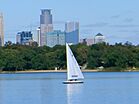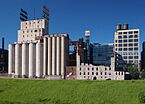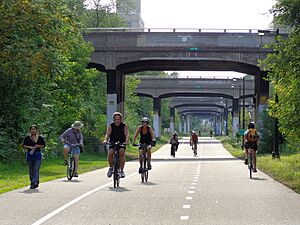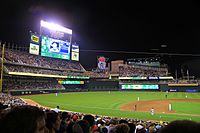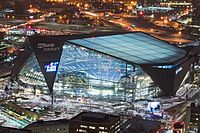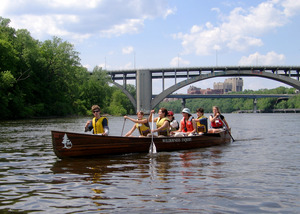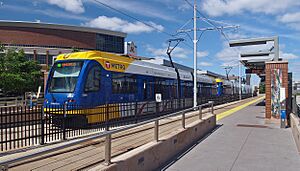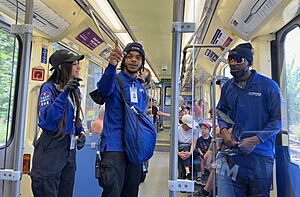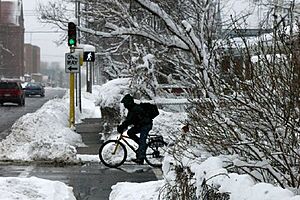Minneapolis facts for kids
Quick facts for kids
Minneapolis
|
|||||
|---|---|---|---|---|---|
|
City
|
|||||
|
Downtown Minneapolis (from the Mississippi River)
First Avenue
|
|||||
|
|||||
| Etymology: Dakota mni 'water' with Greek polis 'city' | |||||
| Nicknames:
"City of Lakes", "Mill City", "Twin Cities" (with Saint Paul), "Mini Apple"
|
|||||
| Motto(s):
En Avant (French: 'Forward')
|
|||||
| Country | United States | ||||
| State | Minnesota | ||||
| County | Hennepin | ||||
| Incorporated | 1867 | ||||
| Founded by | Franklin Steele and John H. Stevens | ||||
| Government | |||||
| • Type | Mayor–council (strong mayor) | ||||
| • Body | Minneapolis City Council | ||||
| Area | |||||
| • City | 57.51 sq mi (148.94 km2) | ||||
| • Land | 54.00 sq mi (139.86 km2) | ||||
| • Water | 3.51 sq mi (9.08 km2) | ||||
| Elevation | 830 ft (250 m) | ||||
| Population
(2020)
|
|||||
| • City | 429,954 | ||||
| • Estimate
(2023)
|
425,115 | ||||
| • Rank |
|
||||
| • Density | 7,962.11/sq mi (3,074.21/km2) | ||||
| • Urban | 2,914,866 | ||||
| • Urban density | 2,872.4/sq mi (1,109/km2) | ||||
| • Metro | 3,693,729 | ||||
| Demonym(s) | Minneapolitan | ||||
| GDP | |||||
| • MSA | 3.9 billion (2022) ($324 billion in 2022) | ||||
| Time zone | UTC–6 (Central) | ||||
| • Summer (DST) | UTC–5 (CDT) | ||||
| ZIP Codes |
55401-55419, 55423, 55429-55430, 55450, 55454-55455, 55484-55488
|
||||
| Area code | 612 | ||||
| FIPS code | 27-43000 | ||||
| GNIS ID | 655030 | ||||
Minneapolis (pronounced MIN-ee-AP-ə-liss) is a big city in Minnesota, USA. It's the largest city in the state, with over 429,000 people living there. Minneapolis sits on both sides of the Mississippi River. It's right next to Saint Paul, which is the state capital. Together, Minneapolis and Saint Paul are known as the Twin Cities. About 3.69 million people live in this larger area.
Minneapolis is often called the "City of Lakes" because it has many lakes, wetlands, and waterfalls. The city's beautiful park system is connected by a special road called the Grand Rounds National Scenic Byway.
Long ago, the Dakota people lived where Minneapolis is now. European settlers arrived near Saint Anthony Falls, the only natural waterfall on the Mississippi River. This waterfall was important for early industries. In the 1800s, Minneapolis became a world leader in lumber and flour milling. Today, it's still an important financial center. Many famous companies started here, like General Mills and Target Corporation.
The city has many cool places for arts and culture, including the Minneapolis Institute of Art and the Walker Art Center. You can also find four professional sports teams playing downtown. The famous musician Prince loved the First Avenue nightclub here. Minneapolis is also home to the main campus of the University of Minnesota.
Minneapolis is a diverse city where people practice over fifty different religions. The city is always working to make life better for everyone. It is governed by a mayor and a city council. The current mayor is Jacob Frey.
Contents
- Discovering Minneapolis History
- Minneapolis Geography
- People of Minneapolis: Demographics
- Minneapolis Economy
- Arts and Culture in Minneapolis
- Sports in Minneapolis
- Parks and Fun in Minneapolis
- Education in Minneapolis
- Minneapolis Media
- City Services and Transportation
- Famous People from Minneapolis
- Minneapolis Sister Cities
- See also
Discovering Minneapolis History
Early People: The Dakota Homeland
Long before European settlers arrived, two Native American groups lived in the area now known as Minneapolis. The Dakota people were here around 1000 A.D. Later, after the 1700s, the Ojibwe people also lived in the region. The Dakota people have a special connection to this land. One story says they came from Bdóte, where the Minnesota and Mississippi rivers meet. This means they believe they have always been here.
In 1680, a European explorer named Louis Hennepin was likely the first European to see the waterfall the Dakota called Owámniyomni. He renamed it the Falls of St. Anthony of Padua. This waterfall became very important for the city's growth.
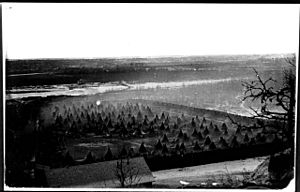
Over time, the US government took most of the Dakota land. In 1805, Zebulon Pike made a treaty with the Dakota people. He bought a small piece of land near Saint Anthony Falls. The US Army built Fort Snelling there in 1819. This fort was meant to control trade and prevent wars between Native American groups.
More treaties followed, and the Dakota gave up more of their land. Sadly, the US government often did not keep its promises. In 1862, during the American Civil War, the Dakota people faced starvation because payments they were promised were late. This led to a conflict called the Dakota War of 1862. After the war, many Dakota people were forced to leave Minnesota.
As the Dakota people were being moved, settlers like Franklin Steele and John H. Stevens claimed land near Saint Anthony Falls. The city's name, Minneapolis, comes from the Dakota word mni (meaning 'water') and the Greek word polis (meaning 'city'). Minneapolis officially became a city in 1867. In 1872, it joined with the nearby town of St. Anthony.
Growing Industries: Mill City's Rise
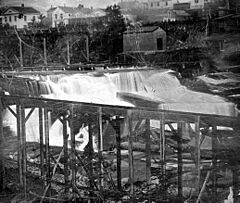
Minneapolis grew because of the power from Saint Anthony Falls. In the 1800s, two main industries became very important: flour milling and lumber milling. For about fifty years, Minneapolis was a major center for both. Soldiers from Fort Snelling built early sawmills and gristmills (for grinding grain) here.
By 1884, Minneapolis was the world's top flour milling city. In 1899, it sold more lumber than any other place. This is why Minneapolis earned the nickname "Mill City." The dangerous work in the mills even led to companies making artificial limbs.
There were also some big disasters. In 1869, a tunnel under the river leaked. Fires destroyed sawmills, and a flour dust explosion at the Washburn A mill killed 18 people. Another fire in 1893 destroyed many buildings.
The lumber industry used forests in northern Minnesota. Logs were floated down the Mississippi River to the city. Minneapolis supplied wood for new farms and growing cities in the prairies. But by the early 1900s, the lumber industry started to decline as the forests were used up.
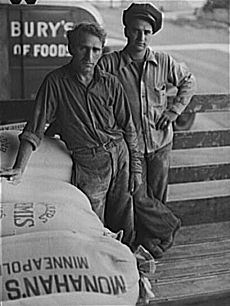
In 1877, Cadwallader C. Washburn started Washburn-Crosby, which later became General Mills. They learned new milling methods from Hungary. Charles Alfred Pillsbury also used these new methods. The special wheat grown in Minnesota became very valuable. By 1900, a lot of America's grain was milled in Minneapolis.
However, problems like soil issues and changes in shipping costs caused the flour industry to slow down. In the 1920s, General Mills and Pillsbury opened new milling centers in other cities, but their main offices stayed in Minneapolis. The falls area is now a historic district.
After the milling era, Minneapolis grew into a modern city. It attracted skilled workers. In 1923, Munsingwear was the world's largest underwear maker. Frederick McKinley Jones invented mobile refrigeration here, starting Thermo King in 1938. Medtronic, a medical device company, began in a Minneapolis garage in 1949.

In 1957, Control Data started in downtown Minneapolis. They made important computers using new technology. This company brought many jobs to the city. The University of Minnesota also created "Gopher," an early internet system, in 1991.
Social Changes and Challenges
The 20th century brought many changes to Minneapolis. For a long time, there were problems with corruption in the city government.
During the Great Depression in 1934, truck drivers went on strike. They wanted better rights and pay. Their success helped lead to new federal laws that protect workers' rights across the country.
For many years, there was unfair treatment against Jewish people in Minneapolis. In the 1940s, Mayor Hubert Humphrey worked to improve the city's image. He helped create rules to ensure fair employment for all people. However, life for Black people in the city still had many challenges.
In the 1960s, there were protests and unrest in Minneapolis, like in other US cities. These events showed the anger among the Black population about unfair treatment. While these events were not as severe as in some other cities, they highlighted the need for change.

In the second half of the 20th century, Minneapolis changed a lot. Between 1958 and 1963, a large part of downtown was rebuilt. In 1968, the American Indian Movement (AIM) started in Minneapolis. They created the Heart of the Earth Survival School to teach Native American traditions.
Immigration helped the city's population grow again after a decline. However, after the 9/11 attacks, some people from Somalia faced discrimination.
In 2020, a video recorded by a teenager showed the death of George Floyd. This event led to huge protests in Minneapolis and around the world. People protested against racial injustice and police actions. The area where George Floyd died is now known as George Floyd Square. Protests continue there, asking for changes and fairness. The city is working with the community to plan for the future of this important place.
Minneapolis Geography

Minneapolis's history and growth are closely tied to water. Long ago, glaciers shaped the land. When the ice melted, it created the many lakes in Minneapolis. About 10,000 years ago, a huge waterfall formed on the Mississippi River. This waterfall, later called Saint Anthony Falls, slowly moved upstream, carving the Mississippi River gorge. Minnehaha Falls also formed this way.
Minneapolis is built on flat land with water underground. About six percent of the city's total area is covered by water. The city has 12 miles of the Mississippi River, four streams, and 17 bodies of water. Thirteen of these are lakes, with 24 miles of lake shoreline.
The city's elevation above sea level is about 830 feet. The lowest point is near Minnehaha Creek, at 687 feet. The highest point is in the Northeast section of the city, between 967 and 985 feet above sea level.
City Neighborhoods
Minneapolis has 83 neighborhoods, each with its own community group. These groups help residents connect with the city government.
Around 1990, the city started the Neighborhood Revitalization Program (NRP). This program gave money to neighborhoods to help them improve. It was seen as a great example of how cities can work with their residents. After NRP ended in 2011, a new program called Neighborhoods 2020 started. This program aims to make funding fairer for all neighborhoods.
In 2018, the city made a big change to its housing rules. It ended rules that only allowed single-family homes in many areas. This means more types of housing can be built in more neighborhoods. The goal is to make housing more affordable and reduce unfair differences between neighborhoods. This plan has faced some challenges but was approved by the state in 2024.
Minneapolis Climate and Weather
Minneapolis has a climate with hot summers and cold, snowy winters. This is typical for the Upper Midwest. The city gets all kinds of weather, including snow, ice, rain, thunderstorms, and fog.
The highest temperature ever recorded was 108°F in July 1936. The lowest was -41°F in January 1888. The winter of 1983–1984 had the most snow, with 98.6 inches. The winter of 1930–1931 had the least snow, with only 14.2 inches. On average, Minneapolis gets sunshine about 58 percent of the time.
| Climate data for Minneapolis–Saint Paul International Airport, Minnesota (1991–2020 normals, extremes 1872–present) | |||||||||||||
|---|---|---|---|---|---|---|---|---|---|---|---|---|---|
| Month | Jan | Feb | Mar | Apr | May | Jun | Jul | Aug | Sep | Oct | Nov | Dec | Year |
| Record high °F (°C) | 58 (14) |
65 (18) |
83 (28) |
95 (35) |
106 (41) |
104 (40) |
108 (42) |
103 (39) |
104 (40) |
92 (33) |
77 (25) |
68 (20) |
108 (42) |
| Mean maximum °F (°C) | 42.5 (5.8) |
46.7 (8.2) |
64.7 (18.2) |
79.7 (26.5) |
88.7 (31.5) |
93.3 (34.1) |
94.4 (34.7) |
91.7 (33.2) |
88.3 (31.3) |
80.1 (26.7) |
62.1 (16.7) |
47.1 (8.4) |
96.4 (35.8) |
| Mean daily maximum °F (°C) | 23.6 (−4.7) |
28.5 (−1.9) |
41.7 (5.4) |
56.6 (13.7) |
69.2 (20.7) |
79.0 (26.1) |
83.4 (28.6) |
80.7 (27.1) |
72.9 (22.7) |
58.1 (14.5) |
41.9 (5.5) |
28.8 (−1.8) |
55.4 (13.0) |
| Daily mean °F (°C) | 16.2 (−8.8) |
20.6 (−6.3) |
33.3 (0.7) |
47.1 (8.4) |
59.5 (15.3) |
69.7 (20.9) |
74.3 (23.5) |
71.8 (22.1) |
63.5 (17.5) |
49.5 (9.7) |
34.8 (1.6) |
22.0 (−5.6) |
46.9 (8.3) |
| Mean daily minimum °F (°C) | 8.8 (−12.9) |
12.7 (−10.7) |
24.9 (−3.9) |
37.5 (3.1) |
49.9 (9.9) |
60.4 (15.8) |
65.3 (18.5) |
62.8 (17.1) |
54.2 (12.3) |
40.9 (4.9) |
27.7 (−2.4) |
15.2 (−9.3) |
38.4 (3.6) |
| Mean minimum °F (°C) | −14.7 (−25.9) |
−8 (−22) |
2.7 (−16.3) |
21.9 (−5.6) |
35.7 (2.1) |
47.3 (8.5) |
54.5 (12.5) |
52.3 (11.3) |
38.2 (3.4) |
26.0 (−3.3) |
9.2 (−12.7) |
−7.1 (−21.7) |
−16.9 (−27.2) |
| Record low °F (°C) | −41 (−41) |
−33 (−36) |
−32 (−36) |
2 (−17) |
18 (−8) |
34 (1) |
43 (6) |
39 (4) |
26 (−3) |
10 (−12) |
−25 (−32) |
−39 (−39) |
−41 (−41) |
| Average precipitation inches (mm) | 0.89 (23) |
0.87 (22) |
1.68 (43) |
2.91 (74) |
3.91 (99) |
4.58 (116) |
4.06 (103) |
4.34 (110) |
3.02 (77) |
2.58 (66) |
1.61 (41) |
1.17 (30) |
31.62 (803) |
| Average snowfall inches (cm) | 11.0 (28) |
9.5 (24) |
8.2 (21) |
3.5 (8.9) |
0.0 (0.0) |
0.0 (0.0) |
0.0 (0.0) |
0.0 (0.0) |
0.0 (0.0) |
0.8 (2.0) |
6.8 (17) |
11.4 (29) |
51.2 (130) |
| Average extreme snow depth inches (cm) | 8 (20) |
9 (23) |
8 (20) |
2 (5.1) |
0 (0) |
0 (0) |
0 (0) |
0 (0) |
0 (0) |
0 (0) |
4 (10) |
7 (18) |
9 (23) |
| Average precipitation days (≥ 0.01 in) | 9.6 | 7.8 | 9.0 | 11.2 | 12.4 | 11.8 | 10.4 | 9.8 | 9.3 | 9.5 | 8.3 | 9.7 | 118.8 |
| Average snowy days (≥ 0.1 in) | 9.3 | 7.3 | 5.2 | 2.4 | 0.1 | 0.0 | 0.0 | 0.0 | 0.0 | 0.6 | 4.5 | 8.8 | 38.2 |
| Average relative humidity (%) | 69.9 | 69.5 | 67.4 | 60.3 | 60.4 | 63.8 | 64.8 | 67.9 | 70.7 | 68.3 | 72.6 | 74.1 | 67.5 |
| Average dew point °F (°C) | 4.1 (−15.5) |
9.5 (−12.5) |
20.7 (−6.3) |
31.6 (−0.2) |
43.5 (6.4) |
54.7 (12.6) |
60.1 (15.6) |
58.3 (14.6) |
49.8 (9.9) |
37.9 (3.3) |
25.0 (−3.9) |
11.1 (−11.6) |
33.9 (1.0) |
| Mean monthly sunshine hours | 156.7 | 178.3 | 217.5 | 242.1 | 295.2 | 321.9 | 350.5 | 307.2 | 233.2 | 181.0 | 112.8 | 114.3 | 2,710.7 |
| Percent possible sunshine | 55 | 61 | 59 | 60 | 64 | 69 | 74 | 71 | 62 | 53 | 39 | 42 | 59 |
| Average ultraviolet index | 1 | 2 | 3 | 5 | 7 | 8 | 8 | 7 | 5 | 3 | 2 | 1 | 4 |
| Source 1: NOAA (relative humidity, dew point and sun 1961–1990) | |||||||||||||
| Source 2: Weather Atlas (UV) | |||||||||||||
Minneapolis Cityscape
People of Minneapolis: Demographics
| Historical population | |||
|---|---|---|---|
| Census | Pop. | %± | |
| 1860 | 5,809 | — | |
| 1870 | 13,066 | 124.9% | |
| 1880 | 46,887 | 258.8% | |
| 1890 | 164,738 | 251.4% | |
| 1900 | 202,718 | 23.1% | |
| 1910 | 301,408 | 48.7% | |
| 1920 | 380,582 | 26.3% | |
| 1930 | 464,356 | 22.0% | |
| 1940 | 492,370 | 6.0% | |
| 1950 | 521,718 | 6.0% | |
| 1960 | 482,872 | −7.4% | |
| 1970 | 434,400 | −10.0% | |
| 1980 | 370,951 | −14.6% | |
| 1990 | 368,383 | −0.7% | |
| 2000 | 382,618 | 3.9% | |
| 2010 | 382,578 | 0.0% | |
| 2020 | 429,954 | 12.4% | |
| 2023 (est.) | 425,115 | 11.1% | |
The Minneapolis area was first home to the Dakota people. Then, people from Europe and other parts of the US began to move here. Settlers from New England, like Maine and Massachusetts, had a big impact on the city's early life.
Later, people from Mexico started coming to Minnesota. They settled in neighborhoods like Phillips and Whittier. Before the year 2000, Latinos were the fastest-growing immigrant group in the state.
Many immigrants from Sweden, Norway, and Denmark also came to Minneapolis. They shared similar beliefs with the earlier settlers. After the Civil War, people from Ireland, Scotland, and England arrived. Germans, Jews, and Russians followed. Italians and Greeks came in the late 1800s and early 1900s. People from Slovakia, Czechia, and Ukraine also made their homes here.
Chinese immigrants began arriving in the 1870s. Many had faced discrimination in western states. Japanese Americans also came, especially after World War II. By 1970, nearly 2,000 Japanese Americans lived in Minneapolis. In the 1950s, the US government helped Native Americans move to cities like Minneapolis.
More recently, people from Korea, the Philippines, Vietnam, Hmong, Laos, and Cambodia have settled in the Twin Cities. In 1992, many Tibetan immigrants came to Minnesota. Burmese immigrants arrived in the early 2000s. The number of people from India in Minneapolis also grew a lot between 2000 and 2010.
Minneapolis's population grew until 1950, when it reached its highest point of over 521,000 people. After World War II, many people moved to the suburbs, and the city's population declined for decades.
By 1930, Black residents in Minneapolis had a high literacy rate. However, they still faced discrimination in getting good jobs and housing. In the 1990s, many immigrants from the Horn of Africa, especially Somalia, began to arrive. As of 2022, about 20,000 Somalis live in Minneapolis.
The Twin Cities area has a notable LGBT adult population. In 2023, Minneapolis scored high on an index that measures support for the LGBTQ+ community. The Twin Cities Pride celebration is held in May.
Population Facts and Figures
Minneapolis is the largest city in Minnesota. It is the 46th largest city in the United States by population in 2023. In 2020, Minneapolis had 429,954 people. About 10.4 percent of the population identified as Hispanic or Latino.
Of those not Hispanic or Latino, about 58.0 percent were White. About 18.9 percent were Black or African American. About 5.8 percent were Asian, and 1.2 percent were American Indian and Alaska Native. About 5.2 percent identified as multiracial.
The most common family backgrounds in Minneapolis are German, Irish, Norwegian, and Swedish. Most people (81.2 percent) speak only English at home. However, many also speak Spanish (7.1 percent) and other languages like Somali and Hmong. About 13.7 percent of the people in Minneapolis were born in other countries.
In 2021, the average household income in Minneapolis was about $69,397. The average rent in 2023 was $1,529. Over 92 percent of homes in Minneapolis were lived in. Almost 17 percent of residents lived in poverty in 2023.
In 2022, about 90.8 percent of adults had a high school degree or higher. Also, 53.5 percent had a bachelor's degree or higher. This is higher than the national average.
Understanding Community Differences
For a long time, Minneapolis had rules that made it hard for non-White people to own homes in certain areas. These rules, called restrictive covenants, created separate neighborhoods. Even though these rules were made illegal in the 1950s and 1960s, their effects are still seen today. In 2021, the city created a way for residents to remove these old rules from their property deeds.
Minneapolis has a history of unfair treatment based on race. This has led to differences in many parts of society. When White settlers took land from Native Americans, it started a pattern of control over land. This has shaped how people live in the city today.
These past rules about housing have affected home values, wealth, and even access to green spaces and health. City leaders have recognized that old housing policies created problems. They have worked to change zoning laws and declared racism a public health emergency in 2020. This shows the city's effort to address these differences and create a fairer community for everyone.
Religious Life in Minneapolis

Most people in the Twin Cities (70 percent) are Christian. Early settlers in Minneapolis were mostly Protestants. The oldest church still in use, Our Lady of Lourdes Catholic Church, was built in 1856. St. Mary's Orthodox Cathedral was founded in 1887.
Many beautiful churches were built in Minneapolis, like St. Mark's Episcopal Cathedral and Hennepin Avenue United Methodist Church. The Basilica of Saint Mary was the first basilica in the US. The Billy Graham Evangelistic Association was based in Minneapolis for many years.
After Christians, the next largest group in the metro area (23 percent) are people who do not identify with a religion. However, Minneapolis is home to over 50 different religions. Temple Israel, the city's first Jewish congregation, was built in 1928. A Temple of Islam was in north Minneapolis by 1959.
In 1971, a Hindu temple opened near the University of Minnesota. Many Somalis in Minneapolis are Sunni Muslim. In 2022, Minneapolis changed its rules to allow the Muslim call to prayer to be broadcast five times a day. The city also has about seven Buddhist centers.
Minneapolis Economy
| Rank | Company/Organization |
| 1 | Hennepin Healthcare |
| 2 | Target Corporation |
| 3 | Hennepin County |
| 4 | Wells Fargo |
| 5 | Ameriprise Financial |
| 6 | U.S. Bancorp |
| 7 | Xcel Energy |
| 8 | City of Minneapolis |
| 9 | SPS Commerce |
| 10 | RBC Wealth Management |
| Minneapolis rank |
Corporation | US rank | Revenue (in millions) |
| 1 | Target Corporation | 33 | $109,120 |
| 2 | U.S. Bancorp | 149 | $27,401 |
| 3 | Xcel Energy | 271 | $15,310 |
| 4 | Ameriprise Financial | 289 | $14,347 |
| 5 | Thrivent | 412 | $9,347 |
The early milling and lumber industries needed a lot of money. This helped Minneapolis become a major financial center. The Minneapolis Grain Exchange was founded in 1881. It's still the only place where certain types of wheat are traded.
The Federal Reserve Bank of Minneapolis serves Minnesota and several other states. It's one of twelve such banks in the US.
Most jobs in Minneapolis are in areas like trade, transportation, education, health services, and business services. Fewer people work in government, manufacturing, or hospitality.
In 2024, the Twin Cities area had the eighth-highest number of major company headquarters in the US. Five large companies, including Target Corporation and U.S. Bancorp, have their main offices in Minneapolis. The total value of goods and services produced in the metro area was $323.9 billion in 2022.
Arts and Culture in Minneapolis
Visual Arts and Museums
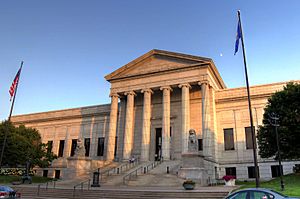
The Walker Art Center started as a private art collection. Around 1940, it began to focus on modern art. The Walker also runs the Minneapolis Sculpture Garden, which has about forty sculptures.
The Minneapolis Institute of Art (Mia) is a large art museum. It opened in 1915 and has over 90,000 artworks from all over the world. Admission to Mia is usually free.
Frank Gehry designed the Weisman Art Museum for the University of Minnesota. It opened in 1993 and has unique architecture. The Museum of Russian Art opened in 2005. The Northeast Minneapolis Arts District is home to many artists and studios. They host an "Art-A-Whirl" event every May.
Theater and Live Performances
Minneapolis has been a place for theater since the 1800s. Many theater companies perform in the city.
The Guthrie Theater is a very famous regional theater. It was founded in 1963 and has a special stage that sticks out into the audience. A new Guthrie building, designed by French architect Jean Nouvel, opened in 2006. It overlooks the Mississippi River.
The city bought and fixed up old theaters like the Orpheum and State Theatre. These are now used for concerts and plays. Every August, the Minnesota Fringe Festival brings many performances to the city. The May Day Parade is a colorful event held in south Minneapolis each May.
Music Scene

The Minnesota Orchestra plays classical and popular music at Orchestra Hall. They have won Grammy Awards for their recordings. Minneapolis also has several opera companies.
The famous musician Prince was born in Minneapolis and lived here most of his life. In the 1980s, Minneapolis was known for its exciting music scene. Bands like Hüsker Dü and The Replacements, along with Prince, made the First Avenue nightclub a famous spot. The city has many other concert venues, like The Cedar and the Dakota Jazz Club.
Historical Museums
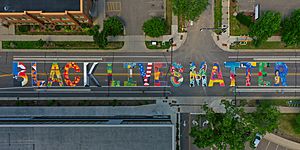
The Mill City Museum shows the history of flour milling in Minneapolis. The Bakken museum focuses on invention and innovation. The Hennepin History Museum is in an old mansion. The small Minnehaha Depot is a historic train station from one of the first railroads.
The American Swedish Institute is in a former mansion. The American Indian Cultural Corridor has a gallery called All My Relatives. The Somali Museum of Minnesota opened in 2013. The Minnesota African American Heritage Museum and Gallery was founded in 2018.
Libraries and Books
In 2008, the Minneapolis Public Library joined with the Hennepin County Library. Fifteen of the system's branches are in Minneapolis. The downtown Central Library is a modern building designed by César Pelli. It opened in 2006.
Several non-profit book publishers are based in Minneapolis, like Coffee House Press and Graywolf Press. The University of Minnesota Press publishes books and journals. The Open Book facility is a special place that houses several literary organizations.
Minneapolis Food Scene
After the 1950s, many people moved to the suburbs, and streetcar service ended. This led to some areas, like north Minneapolis, having fewer grocery stores. In 2017, 70,000 people in north Minneapolis had access to only two grocery stores. When one closed in 2023, it became a "food desert" again.
The non-profit Appetite for Change works to improve healthy eating in the city. They run gardens, sell fresh produce, and have received grants to help create a long-term food home. Minneapolis has over twenty farmers markets.
Several Minneapolis chefs and writers have won national food awards, like Gavin Kaysen and Sean Sherman. Sherman's restaurant, Owamni, won "best new restaurant" in 2022.
The Milky Way candy bar was created in Minneapolis in the 1920s. The famous Jucy Lucy burger, with cheese inside the patty, has been served here since the 1950s by both the 5-8 Club and Matt's Bar. East African food became popular with immigrants from Somalia. The Herbivorous Butcher, a vegan "butcher" shop, opened in 2016.
Sports in Minneapolis
Minneapolis is home to four professional sports teams. The Minnesota Vikings (football) and the Minnesota Twins (baseball) have played in the state since 1961. The Twins won the World Series in 1987 and 1991. They play at Target Field. The Vikings have played in four Super Bowls.
The Minnesota Timberwolves (men's basketball) returned NBA basketball to Minneapolis in 1989. The Minnesota Lynx (women's basketball) started in 1999. Both basketball teams play at the Target Center. The Lynx are very successful, winning four WNBA championships between 2011 and 2017.
Other professional teams, like the Minnesota Frost (women's hockey) and the Minnesota Wild (men's hockey), play in Saint Paul. The soccer team Minnesota United FC also plays in Saint Paul.
The University of Minnesota's college sports teams, the Minnesota Golden Gophers, play in Minneapolis. The football team plays at Huntington Bank Stadium and has won seven national championships. The women's ice hockey team has won six NCAA championships. The men's ice hockey team has won five NCAA championships. Both basketball teams play at Williams Arena.
The U.S. Bank Stadium, home to the Vikings, cost over $1.1 billion to build. It opened in 2016 and can hold 66,000 to 70,000 fans. It also hosts indoor running and rollerblading. Minneapolis has two public golf courses and one private course. The U.S. Pond Hockey Championships are held on Lake Nokomis every January, though sometimes warm weather causes cancellations. The Twin Cities Marathon is held in October.
Parks and Fun in Minneapolis
The Minneapolis park system is very famous. It was designed by landscape architect Horace Cleveland in the 1880s. He connected natural landmarks with beautiful roads and paths. Many people say Minneapolis has one of the best public park systems in America.
Cleveland also helped create a park around Minnehaha Falls. This 53-foot waterfall is now part of Minnehaha Park, one of Minnesota's first state parks. The falls became a symbol of the city.
The city's parks are managed by the Minneapolis Park and Recreation Board. This board owns almost all the land along the city's waterfronts, so the public can enjoy the lakeshores. They also own Theodore Wirth Park, a very large park that includes a wildflower garden.
About 15 percent of Minneapolis's land is parks. Almost all residents (98 percent) live within half a mile of a park. The city's Chain of Lakes connects five lakes in southwest Minneapolis. These lakes are used for swimming, fishing, boating, and ice skating. Paths for biking, running, and walking connect the lakes and run along the 51-mile Grand Rounds National Scenic Byway.
The Mississippi National River and Recreation Area also connects parks along the river. The Winchell Trail is a hiking path along the Mississippi Gorge. The Minneapolis Aquatennial is a celebration of the "City of Lakes" held every July.
Minneapolis's climate offers many winter activities. You can go ice fishing, snowshoeing, ice skating, cross-country skiing, and sledding. In winter, the park board maintains 43 outdoor ice rinks.
Education in Minneapolis
Schools for Kids and Teens
In 1834, missionaries built an Indian mission near Lake Harriet. This was the first school in the Minneapolis area. They tried to teach the Dakota people new farming methods and their religion. Later, as more settlers arrived, the number of schools grew. By 1874, ten school buildings served nearly 4,000 students.
Minneapolis Public Schools has space for 45,000 students. As of 2024, about 28,500 students from kindergarten to 12th grade attend over fifty schools. These include community schools and magnet schools. The number of students is slowly decreasing. This is partly because fewer children live in the city and more students are choosing charter schools.
There are 28 charter schools in Minneapolis. These schools are free and open to all students. Some students also attend alternative schools or are homeschooled.
In Minneapolis public schools, about 41 percent of students are White, 35 percent are Black, and 14 percent are Hispanic. About 5 percent are Asian and 5 percent are Native American. Many students (about 17 percent) are learning English, and over 100 languages are spoken at home. All public school students in Minnesota now receive free breakfast and lunch. In 2022, the district's graduation rate was 77 percent.
Colleges and Universities
The main campus of the University of Minnesota is in Minneapolis. It had over 54,000 students in 2023–2024. This university is ranked among the top schools worldwide. It has a special independence from city government. The university was founded in 1851.
Other colleges in Minneapolis include Augsburg University, Minneapolis College of Art and Design, and North Central University. These are private four-year colleges. Minneapolis Community and Technical College and Dunwoody College of Technology offer career training and two-year degrees.
Saint Mary's University of Minnesota has a campus here for its advanced programs. Red Lake Nation College opened a new site in Minneapolis in 2024. It teaches Ojibwe culture. Large online universities like Capella University and Walden University are also based in the city. Minneapolis has over twenty-five licensed career schools.
Minneapolis Media
Many newspapers are published in Minneapolis. These include Insight News, Finance & Commerce, and the Star Tribune. There are also papers for specific communities, like La Prensa de Minnesota (Spanish) and The American Jewish World. Other local news sources include Southwest Voices and MinnPost.
Minneapolis companies also publish national magazines, such as Foodservice News and Franchise Times. Other magazines include American Craft and the literary journal Rain Taxi. University student publications and professional magazines are also published here.
The Minneapolis–Saint Paul area is the 15th-largest TV market in the US. Many radio stations can be heard in the city. There are 17 FM stations and 11 AM stations licensed in Minneapolis. The Twin Cities have many TV channels available.
City Services and Transportation
Getting Around Minneapolis
In 2019, most people in Minneapolis traveled by driving alone (40 percent). Other ways to get around included carpooling (28 percent), walking (16 percent), bicycling (3 percent), and public transit (13 percent). The city wants 60 percent of trips to be taken without a car by 2030.
Metro Transit runs the public transportation system. As of 2023, it has two light rail lines, five bus rapid transit (BRT) lines, and one commuter rail line. A large fleet of 736 buses serves over 10,000 bus stops. In 2023, the system provided nearly 45 million rides.
The Metro Blue Line light rail connects downtown Minneapolis to the Minneapolis–Saint Paul International Airport. The Green Line goes from downtown Minneapolis through the University of Minnesota to downtown Saint Paul. New light rail extensions are planned for the future. BRT lines are faster than regular buses because riders pay before getting on.
The Northstar Commuter rail runs from Big Lake to downtown Minneapolis. During the COVID-19 pandemic, fewer people rode the commuter rail, so service was reduced.
In 2007, the Interstate 35W bridge collapsed, killing 13 people. The bridge was rebuilt very quickly, in just 14 months.
Minneapolis and Saint Paul share Evie Carshare, a fleet of 145 electric cars. You can rent these cars for one-way trips. In warm weather, companies like Lime and Veo offer shared electric bikes and scooters.
Minneapolis has many bike paths. There are 16 miles of protected bikeways on streets, 98 miles of bike lanes, and 101 miles of off-street paths. These paths include the Grand Rounds National Scenic Byway and the Midtown Greenway.
The Minneapolis Skyway System is a network of enclosed pedestrian bridges. It connects 80 city blocks downtown. You can walk between buildings, restaurants, and shops on the second floor.
Minneapolis–Saint Paul International Airport (MSP) serves the Twin Cities. Many airlines fly from MSP. It is the headquarters of Sun Country Airlines.
City Services and Utilities
Xcel Energy provides electricity, and CenterPoint Energy provides gas. The city's water supply is managed by four watershed districts.
Minneapolis has nineteen fire stations. If you need non-emergency information or services, you can call Minneapolis 311. The call center can help in many languages.
The city's public works department handles things like snow plowing, trash removal, and street maintenance. They also manage water treatment and transportation planning. For example, they are working on a large storm water tunnel system downtown to help with heavy rain.
Downtown Improvement District ambassadors patrol downtown Minneapolis. They wear bright jackets and help visitors, remove trash, and keep an eye on things. This program is paid for by a special downtown tax.
Famous People from Minneapolis
Minneapolis Sister Cities
Minneapolis has "sister cities" around the world. These are cities that have special partnerships to promote cultural exchange and understanding.
 Bosaso, Somalia (2014)
Bosaso, Somalia (2014) Cuernavaca, Mexico (2008)
Cuernavaca, Mexico (2008) Eldoret, Kenya (2000)
Eldoret, Kenya (2000) Harbin, China (1992)
Harbin, China (1992) Ibaraki, Japan (1980)
Ibaraki, Japan (1980) Kuopio, Finland (1972)
Kuopio, Finland (1972) Najaf, Iraq (2009)
Najaf, Iraq (2009) Novosibirsk, Russia (1988)
Novosibirsk, Russia (1988) Santiago, Chile (1961)
Santiago, Chile (1961) Tours, France (1991)
Tours, France (1991) Uppsala, Sweden (2000)
Uppsala, Sweden (2000) Winnipeg, Canada (1973)
Winnipeg, Canada (1973)
See also
 In Spanish: Mineápolis para niños
In Spanish: Mineápolis para niños



